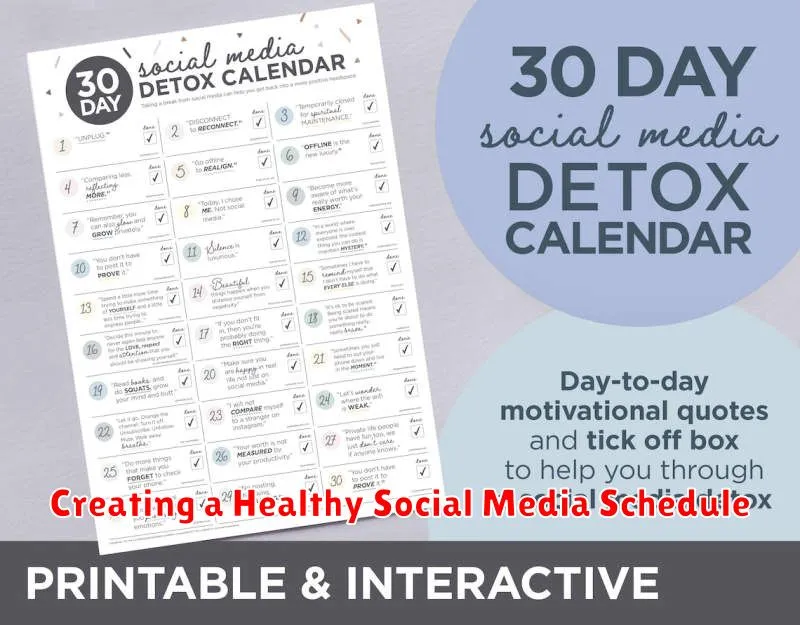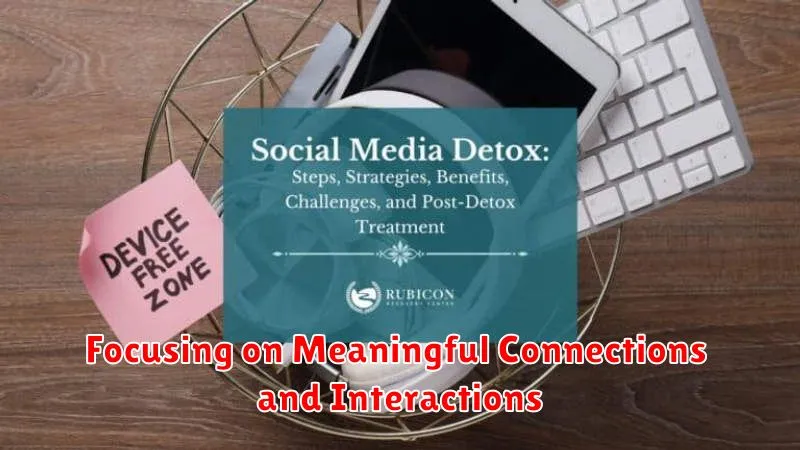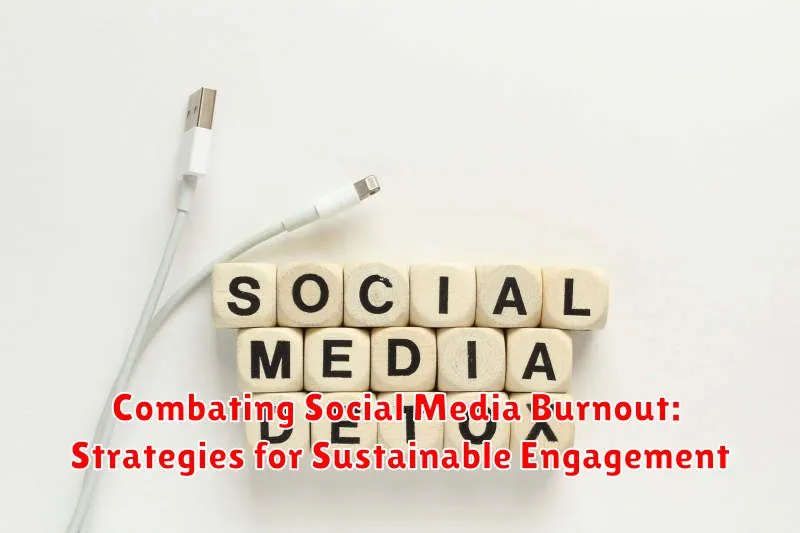In today’s hyper-connected world, social media burnout is a growing concern. Many individuals find themselves overwhelmed by the constant influx of information, the pressure to maintain an online presence, and the pervasive nature of social media platforms. This burnout can manifest in various ways, from decreased productivity and increased anxiety to a general sense of dissatisfaction and disconnection from real-life experiences. Learning how to combat social media burnout and cultivate a more sustainable engagement with these platforms is essential for maintaining mental well-being and a healthy relationship with technology.
This article explores effective strategies for combating social media burnout and fostering sustainable engagement. We will delve into practical techniques for managing your time spent online, setting healthy boundaries, curating your social media feeds, and prioritizing real-world connections. By implementing these strategies, you can reclaim control over your online experience, mitigate the negative effects of social media burnout, and cultivate a more balanced and fulfilling relationship with social media platforms. Join us as we explore how to achieve sustainable engagement and rediscover the positive aspects of online interaction.
Recognizing the Signs of Social Media Burnout
Social media burnout manifests in various ways, often subtly creeping into daily life. Recognizing these signs early is crucial for preventing further negative impact on your well-being.
One key indicator is emotional exhaustion related to social media. This can present as feeling drained, cynical, or apathetic towards platforms you once enjoyed. You may also experience increased anxiety or irritability, especially when using social media.
Reduced engagement is another common sign. You might find yourself mindlessly scrolling without genuine interest, or feeling obligated to post even when lacking motivation. Comparing yourself to others and experiencing feelings of inadequacy are also frequent symptoms of burnout.
Physical manifestations can also occur, such as sleep disturbances, headaches, or eye strain. Recognizing these physical and emotional signs is the first step toward reclaiming a healthy relationship with social media.
Setting Realistic Social Media Goals and Expectations
Often, social media burnout stems from the pressure to maintain a certain online persona or achieve unrealistic goals. Defining achievable and measurable objectives is crucial for a healthy relationship with social media.
Instead of aiming for a massive follower count, focus on engaging with a smaller, more relevant audience. Consider what you realistically want to achieve on social media. Is it to build a professional network, connect with like-minded individuals, or promote a business? Tailor your goals to your specific purpose.
Avoid comparing yourself to others. Everyone’s social media journey is different. Concentrate on your own progress and celebrate small victories. Remember, social media is a tool, and its effectiveness depends on how you use it. Align your expectations with your personal capacity and available time.
Creating a Healthy Social Media Schedule

A structured approach to social media usage can significantly reduce feelings of overwhelm and burnout. Creating a healthy social media schedule involves conscious planning and mindful engagement.
Designate specific times for checking social media platforms. Avoid constantly refreshing feeds throughout the day. Instead, allocate specific blocks of time, perhaps once or twice a day, for engaging with social media.
Set time limits for each session. Use the timer function on your phone or a dedicated app to stay within your allotted time. This helps prevent unconsciously spending excessive time online.
Plan your content in advance. If you manage a business account or frequently post, preparing content ahead of time can streamline your social media activity and reduce the pressure to constantly create new material.
Experiment to find what works best. Your ideal schedule will depend on your personal needs and lifestyle. Be flexible and adjust your schedule as needed to find a sustainable rhythm.
Prioritizing Self-Care and Offline Activities
Combating social media burnout requires a conscious shift away from the digital world and towards activities that nourish your well-being. Prioritizing self-care is not a luxury, but a necessity for maintaining a healthy relationship with social media.
Engage in activities that bring you joy and relaxation. This could include pursuing hobbies, spending time in nature, reading, listening to music, or practicing mindfulness. Physical activity is also crucial. Exercise releases endorphins, which have mood-boosting effects and can help alleviate stress.
Dedicate specific time for offline activities. Schedule these into your day just as you would any other important appointment. This ensures that self-care isn’t neglected.
Explore activities that foster creativity and personal growth. Consider learning a new skill, taking a class, or joining a club. Engaging in activities unrelated to social media can provide a sense of accomplishment and boost self-esteem.
Taking Breaks from Social Media
Stepping away from social media is crucial in combating burnout. Scheduled breaks can provide the mental space needed to recharge and refocus. This could involve dedicating specific times of day, days of the week, or even entire weeks away from platforms.
During these breaks, consider replacing social media time with alternative activities that promote well-being. These could include exercise, spending time in nature, pursuing hobbies, or connecting with loved ones in person.
Disabling notifications, even for short periods, can also significantly reduce the urge to constantly check social media. This creates a more mindful approach to engagement and prevents feeling overwhelmed by the constant influx of information.
Remember, the purpose of a break is to disconnect and rejuvenate. Resist the temptation to check in, allowing yourself the time needed to truly benefit from the break.
Unfollowing Negative or Stressful Accounts
A significant contributor to social media burnout is the constant exposure to negativity. This can range from overtly hostile interactions to subtly stressful content that leaves you feeling drained or inadequate. Unfollowing accounts that consistently trigger negative emotions is a crucial step in reclaiming your online experience.
This doesn’t necessarily mean unfollowing friends or family with whom you have occasional disagreements. Rather, it’s about curating your feed to minimize exposure to sources of stress. This might include accounts that promote unrealistic lifestyles, focus on negativity, or engage in excessive self-promotion.
Consider accounts that leave you feeling: inadequate, envious, anxious, angry, or drained. If an account consistently evokes these feelings, it’s a strong candidate for unfollowing. This act can be surprisingly liberating, freeing up mental space and reducing the overall negativity in your online environment.
Using Social Media Management Tools Efficiently
Social media management tools can be invaluable assets in combating burnout. These tools allow for streamlined scheduling, performance analysis, and engagement tracking, all within a centralized platform. By automating tasks like posting and responding to comments, these tools free up valuable time and mental energy.
Choosing the right tool is crucial. Consider factors like the number of platforms you manage, your budget, and the features that align with your needs. Some tools specialize in specific platforms, while others offer a more comprehensive, multi-platform approach. Explore different options and select the tool that best fits your workflow.
Efficient use of these tools requires planning. Develop a content calendar and schedule posts in advance. This avoids the pressure of constantly generating new content and allows for more strategic posting. Utilize analytics dashboards to track engagement and identify peak posting times. This data-driven approach optimizes your social media presence without demanding constant attention.
Focusing on Meaningful Connections and Interactions

Social media, at its core, is about connection. However, the pursuit of likes and followers can often overshadow the genuine interactions that bring us joy and fulfillment. Shifting your focus back to meaningful connections can significantly reduce burnout and enhance your overall experience.
Engage in genuine conversations. Instead of passively scrolling or simply “liking” posts, take the time to respond thoughtfully to comments and messages. Ask questions, share your perspectives, and contribute to discussions that resonate with you.
Cultivate relationships with like-minded individuals. Seek out online communities or groups that share your interests and values. Engaging in discussions with people who understand your passions can foster a sense of belonging and reduce the pressure to conform to broader social media trends.
Be present and mindful when interacting. Put your phone down when spending time with loved ones in person. Give your full attention to those physically present and savor the experience of real-world connection.
Remember the human element. Behind every profile picture and post is a real person. Treat others with kindness and respect, even when disagreements arise. Focusing on the human connection can make your online interactions more fulfilling and less draining.
Seeking Support from Friends, Family, or Professionals
If you’re struggling with social media burnout, don’t hesitate to seek support. Talking to trusted friends and family members can provide valuable emotional support and practical advice. They can offer different perspectives on your social media usage and help you identify unhealthy patterns.
Sharing your experiences with others who understand can make you feel less alone and more empowered to make positive changes. Sometimes, an outside perspective can help you see things more clearly and develop effective coping mechanisms.
For more structured support, consider reaching out to a therapist or counselor specializing in digital wellness or addiction. They can offer professional guidance and strategies to manage your relationship with social media and address any underlying mental health concerns.
Support groups, both online and offline, can also be beneficial. Connecting with others facing similar challenges creates a sense of community and provides a platform for sharing experiences and coping strategies.

